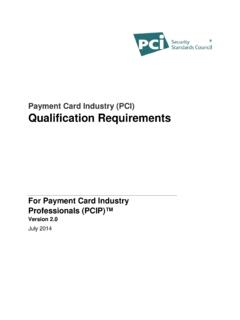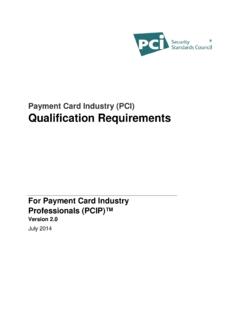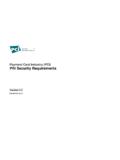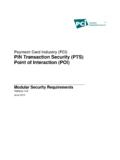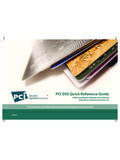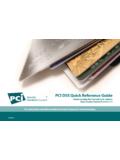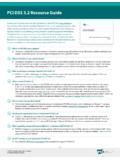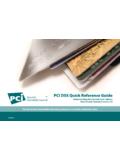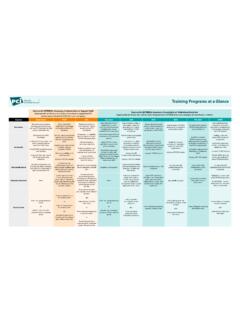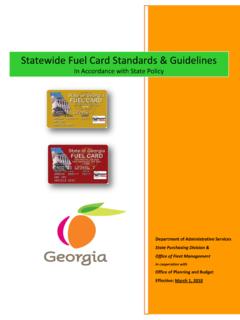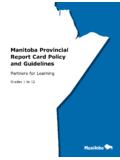Transcription of Payment Card Industry (PCI) Data Security Standard …
1 Payment card Industry (PCI) Data Security Standard self - assessment questionnaire Instructions and guidelines Version May 2016 PCI DSS self - assessment questionnaire Instructions and guidelines , May 2016 2006-2016 PCI Security standards Council, LLC. All Rights Reserved. Page i Document Changes Date Version Description October 1, 2008 To align content with new PCI DSS and to implement minor changes noted since original October 28, 2010 To align content with new PCI DSS and clarify SAQ environment types and eligibility criteria. Addition of SAQ C-VT for Web-based Virtual Terminal merchants June 2012 Addition of SAQ P2PE-HW for merchants who process cardholder data only via hardware Payment terminals included in a validated and PCI SSC-listed PCI Point-to-Point Encryption (P2PE) solution. This document is for use with PCI DSS version April 2015 To align content with PCI DSS , including addition of SAQs A-EP and B-IP, and clarify eligibility criteria for existing SAQs.
2 May 2016 Updated to align with PCI DSS and clarify eligibility criteria for existing SAQs. PCI DSS self - assessment questionnaire Instructions and guidelines , May 2016 2006-2016 PCI Security standards Council, LLC. All Rights Reserved. Page ii Table of Contents Document Changes .. i About this Document .. 1 PCI DSS self - assessment : How it All Fits Together .. 2 SAQ Overview .. 3 Why PCI DSS is 4 Understanding the difference between compliance and Security .. 5 General Tips and Strategies for PCI DSS Compliance .. 5 Selecting the SAQ and Attestation that Best Apply to Your Organization .. 8 SAQ A card -not-present Merchants, All Cardholder Data Functions Fully Outsourced .. 10 SAQ A-EP Partially Outsourced E-Commerce Merchants Using a Third-Party Website for Payment Processing .. 11 SAQ B Merchants with Only Imprint Machines or Only Standalone, Dial-Out Terminals. No Electronic Cardholder Data Storage .. 12 SAQ B-IP Merchants with Standalone, IP-Connected PTS Point-of-Interaction (POI) terminals, No Electronic Cardholder Data Storage.
3 13 SAQ C-VT Merchants with Web-Based Virtual Terminals, No Electronic Cardholder Data Storage . 14 SAQ C Merchants with Payment Application Systems Connected to the Internet, No Electronic Cardholder Data Storage .. 15 SAQ P2PE Merchants using Only Hardware Payment Terminals in a PCI SSC-listed P2PE Solution, No Electronic Cardholder Data Storage .. 16 SAQ D for Merchants All Other SAQ-Eligible Merchants .. 17 SAQ D for Service Providers SAQ-Eligible Service Providers .. 17 Which SAQ Best Applies to My Environment? .. 18 PCI DSS self - assessment questionnaire Instructions and guidelines , May 2016 2006-2016 PCI Security standards Council, LLC. All Rights Reserved. Page 1 About this Document This document was developed to help merchants and service providers understand the Payment card Industry Data Security Standard (PCI DSS) self - assessment Questionnaires (SAQs). In order to understand why PCI DSS is important to your organization, what strategies your organization can use to facilitate PCI DSS compliance validation, and whether your organization is eligible to complete one of the shorter SAQs, we recommend that you review this Instructions and guidelines document in its entirety PCI DSS self - assessment questionnaire Instructions and guidelines , May 2016 2006-2016 PCI Security standards Council, LLC.
4 All Rights Reserved. Page 2 PCI DSS self - assessment : How it All Fits Together The PCI DSS and supporting documents represent a common set of Industry tools to help ensure the safe handling of cardholder data. The Standard itself provides an actionable framework for developing a robust Security process including preventing, detecting, and reacting to Security incidents. To reduce the risk of compromise and mitigate the impact if it does occur, it is important for all entities that store process, or transmit cardholder data to be compliant. The chart below outlines the tools in place to help organizations with PCI DSS compliance and self - assessment . These and other related documents can be found at * Note: Information Supplements provide supplemental information and guidance only, and do not replace or supersede any requirements in PCI DSS. PCI DSS self - assessment questionnaire Instructions and guidelines , May 2016 2006-2016 PCI Security standards Council, LLC. All Rights Reserved.
5 Page 3 SAQ Overview The PCI DSS self - assessment Questionnaires (SAQs) are validation tools intended to assist merchants and service providers in self -evaluating their compliance with the PCI DSS. There are multiple versions of the PCI DSS SAQs to meet various scenarios. This document has been developed to help your organization determine which SAQ(s) best applies to your environment. The PCI DSS SAQ is a validation tool for merchants and service providers not required by their respective acquirers or Payment brand(s) to submit a PCI DSS Report on Compliance (ROC). Please consult your acquirer or Payment brand for details regarding PCI DSS validation requirements. Each PCI DSS SAQ consists of the following components: 1. Questions correlating to the PCI DSS requirements, as appropriate for different environments: See Selecting the SAQ and Attestation that Best Apply to Your Organization in this document. This section also includes a column for Expected Testing which is based on the testing procedures in PCI DSS.
6 2. Attestation of Compliance: The Attestation includes your declaration of eligibility for completing the applicable SAQ and the subsequent results of a PCI DSS self - assessment . PCI DSS self - assessment questionnaire Instructions and guidelines , May 2016 2006-2016 PCI Security standards Council, LLC. All Rights Reserved. Page 4 Why PCI DSS is Important The founding members of the PCI Security standards Council (American Express, Discover, JCB, MasterCard, and Visa) continually monitor occurrences of account data compromise. These compromises cover the full spectrum of organizations, from very small to very large merchants and service providers. A Security breach and subsequent compromise of Payment card data has far-reaching consequences for affected organizations, including: 1. Regulatory notification requirements, 2. Loss of reputation, 3. Loss of customers, 4. Potential financial liabilities (for example, regulatory and other fees and fines), and 5. Litigation. Forensic analysis of compromises has shown that common Security weaknesses, which are addressed by PCI DSS controls, are often exploited because the PCI DSS controls either were not in place or were poorly implemented when the compromise occurred.
7 PCI DSS was designed and includes detailed requirements for exactly this reason to minimize the chance of compromise and the effects if a compromise does occur. Examples of common PCI DSS control failures include, but are not limited to: Storage of sensitive authentication data (SAD), such as track data, after authorization (Requirement ). Many compromised entities were unaware that their systems were storing this data. Inadequate access controls due to improperly installed point-of-sale (POS) systems, allowing malicious users in via paths intended for POS vendors (Requirements , , , and ). Default system settings and passwords not changed when the system was installed (Requirement ). Unnecessary and insecure services not removed or secured when the system was installed (Requirements and ). Poorly coded web applications resulting in SQL injection and other vulnerabilities, which allow access to the database storing cardholder data directly from the website (Requirement ).
8 Missing and outdated Security patches (Requirement ). Lack of logging (Requirement 10). Lack of monitoring (via log reviews, intrusion detection/prevention, quarterly vulnerability scans, and file integrity monitoring systems) (Requirements , , and ). Poor scoping decisions for example, excluding part of the network from PCI DSS scope due to inadequate network segmentation that was not verified to be effective. This results in the cardholder data environment being unknowingly exposed to weaknesses in other parts of the network that have not been secured according to PCI DSS (for example, from unsecured wireless access points and vulnerabilities introduced via employee e-mail and web browsing) (Requirements , and ). PCI DSS self - assessment questionnaire Instructions and guidelines , May 2016 2006-2016 PCI Security standards Council, LLC. All Rights Reserved. Page 5 Understanding the difference between compliance and Security It s important to recognize the difference between being compliant and being secure.
9 Being compliant with PCI DSS at one point in time does not prevent things from changing in your environment, which if the proper controls are not implemented could impact your Security . You should therefore ensure that PCI DSS controls continue to be implemented properly as part of business-as-usual (BAU) activities and as defined by your overall Security strategy. This will enable you to monitor the effectiveness of your organization s Security controls on an ongoing basis and maintain your PCI DSS compliant environment between PCI DSS assessments. Examples of how PCI DSS should be incorporated into BAU activities are provided in the Implementing PCI DSS into Business-as-Usual Processes section in the PCI DSS. Additionally, the PCI DSS Security requirements are intended for the protection of Payment card data, and your organization may have other sensitive data and assets that need protecting which could be outside of the scope of PCI DSS. Therefore, while PCI DSS compliance, if properly maintained, can certainly contribute to overall Security , it should not be viewed as a replacement for a robust, organization-wide Security program.
10 General Tips and Strategies for PCI DSS Compliance Following are some general tips and strategies for beginning your PCI DSS compliance efforts. These tips may help you eliminate storage of cardholder data you do not need, isolate the data you do need to defined and controlled centralized areas, and may allow you to limit the scope of your PCI DSS compliance validation effort. For example, by eliminating cardholder data that you don t need and/or isolating the data that you do need to defined and controlled areas, you can remove systems and networks that don t store, process, or transmit cardholder data and that don t connect to systems that do from the scope of your self - assessment . 1. Sensitive Authentication Data (includes the full track contents of the magnetic stripe or equivalent data on a chip, card verification codes and values, PINs, and PIN blocks): Make sure you never store this data after authorization: 2. Ask your POS vendor about the Security of your system, with the following suggested questions: a.
